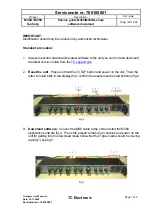
Using the DXP-PRO Wizard
19
DXP-PRO v1.1 - Programmer’s Guide
Using the DXP-PRO Wizard
Design Xpress - Professional (DXP-PRO) uses a Project Wizard to step you through the process of
designing a control system. To launch the Wizard, click the
Create New Project
button on the
Main Screen.
Required Information for Building a System
Before you can begin to use Design XPress - Professional (DXP-PRO) to build a system you must
first gather information about the installation. The most obvious is the project name and a
description of the project. Additionally, you will need the following information:
A list of user interfaces (Touch Panels) models being used.
A list of the audio and/or video sources that will be used (along with a list of their
input/output locations on the switcher(s)). The type of DSS system and a list of channel/
music favorites, if a DSS receiver is included in the system. (DXP-PRO can include
either a DirecTV or Dish Network system.)
If a CD changer is included in the system a list of the installed CDs or the CD collection
should be available while creating the system.
The following information is needed for each type of lighting system supported by
DXP-PRO: system type, baud rate (if applicable), system address, and button or preset
numbers.
This information can be collected in multiple lists or in some instances can be drawn on a floor
plan. Several worksheets are included in the DXP-PRO help file to assist you in collecting this
information.
Common Mistakes
The most common mistake made is modifying the software and then using the application to make
changes. As mentioned before, all software changes outside of the special
CUSTOM.AXI
file will
be overwritten. Only modify the source code generated by DXP-PRO if there is a strong desire to
alter the behavior of the code. To add features, new subsystems, etc. make the changes in the
custom file to avoid the frustration.
DXP-PRO is not a "simple" NetLinx program. Because of the scope and number of features
designed into the system, the code can be quite daunting to someone looking at it, even an
experienced NetLinx programmer. Installers with NetLinx experience should not expect to be able
to modify the software the first time they see it. Most of the features are tied into another feature or
affect another part of the software. The architecture of the system design and the function of the file
being modified should be understood prior to proceeding with changes.
Another common mistake is forgetting to properly address a device. Unless all devices are
addressed as defined in the report file the system will not work as desired.
The lighting system should be configured and programmed before button or preset
numbers are entered into DXP-PRO.
















































